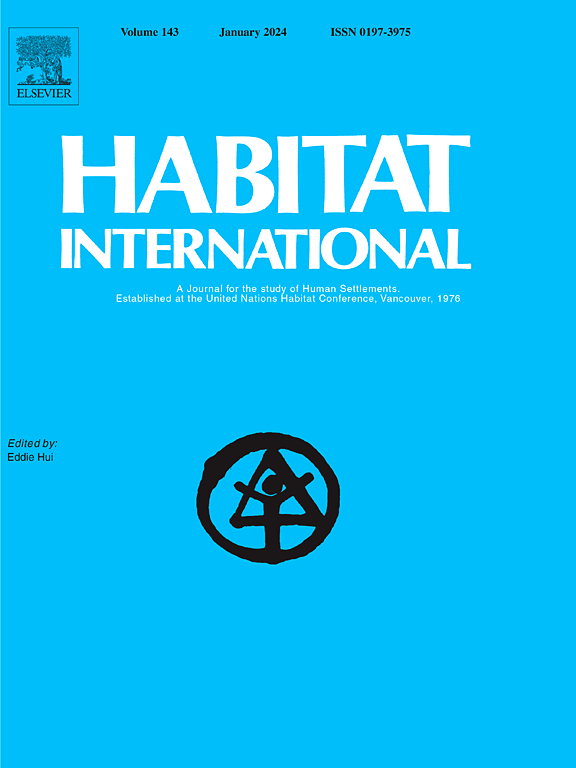Balancing density and open space provision towards sustainable compact cities: Evidence from São Paulo, Brasília and Berlin
IF 7
1区 经济学
Q1 DEVELOPMENT STUDIES
引用次数: 0
Abstract
Cities worldwide face the challenge of balancing densification and open space provision. However, few studies investigate how urban morphology influences that balance across different cities and continents. We identified eight urban morphological types characterizing high-density residential areas in São Paulo, Brasília (Brazil), and Berlin (Germany) and assessed those morphologies using seven indicators: population density, housing density, Floor Space Index (FSI), Ground Space Index (GSI), average building height, Open-Space Ratio (OSR), and average number of people per built area. Our findings from the Brazilian cities showed that intense verticalization does not automatically ensure open space and high density. Vertical morphologies showed the highest FSI values but not the highest housing densities, and had low to moderate OSR values, comparatively. Three morphologies found in Berlin (Contemporary, Half-Open and Edge) balanced housing density and OSR best (127–147 dwellings/ha, 0.5 to 0.8 OSR values, on average). Berlin's Traditional type showed the best balance between FSI, GSI, average building height and OSR, with buildings ranging from 1 to 9 storeys. It also achieved the highest housing densities (188 dwellings/ha, on average), but at a cost of OSR. Those findings suggest that a compact city model with perimetral blocks (Half, Edge and Traditional types) could provide an optimum use of urban space, if open space provision is properly considered. We further discuss the advantages and implications of block-based urban planning and design (traditional in Berlin and other European cities) in contrast to plot-based (often observed in Latin American cities).
平衡密度和开放空间供应,实现可持续紧凑型城市:来自圣保罗、Brasília和柏林的证据
世界各地的城市都面临着平衡密度和开放空间供应的挑战。然而,很少有研究调查城市形态如何影响不同城市和大洲之间的平衡。我们确定了圣保罗、Brasília(巴西)和柏林(德国)高密度住宅区的8种城市形态类型,并使用7个指标对这些形态进行了评估:人口密度、住房密度、建筑面积指数(FSI)、地面空间指数(GSI)、平均建筑高度、开放空间比(OSR)和每个建成区的平均人数。我们对巴西城市的调查结果表明,高度垂直化并不能自动确保开放空间和高密度。垂直形态的FSI值最高,但住宅密度不高,OSR值相对较低至中等。在柏林发现的三种形态(当代、半开放和边缘)最能平衡住房密度和OSR(127-147套/公顷,平均OSR值为0.5至0.8)。柏林的传统类型在FSI、GSI、平均建筑高度和OSR之间表现出最好的平衡,建筑从1层到9层不等。它也实现了最高的住房密度(平均188个住宅/公顷),但代价是消耗了土地资源。这些研究结果表明,如果适当考虑提供开放空间,具有周边街区(半、边缘和传统类型)的紧凑型城市模式可以提供最佳的城市空间利用。我们进一步讨论了基于街区的城市规划和设计(柏林和其他欧洲城市的传统)与基于地块的城市规划和设计(在拉丁美洲城市经常观察到)的优势和影响。
本文章由计算机程序翻译,如有差异,请以英文原文为准。
求助全文
约1分钟内获得全文
求助全文
来源期刊

Habitat International
Multiple-
CiteScore
10.50
自引率
10.30%
发文量
151
审稿时长
38 days
期刊介绍:
Habitat International is dedicated to the study of urban and rural human settlements: their planning, design, production and management. Its main focus is on urbanisation in its broadest sense in the developing world. However, increasingly the interrelationships and linkages between cities and towns in the developing and developed worlds are becoming apparent and solutions to the problems that result are urgently required. The economic, social, technological and political systems of the world are intertwined and changes in one region almost always affect other regions.
 求助内容:
求助内容: 应助结果提醒方式:
应助结果提醒方式:


